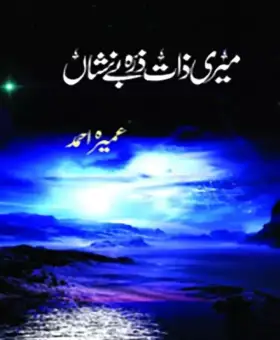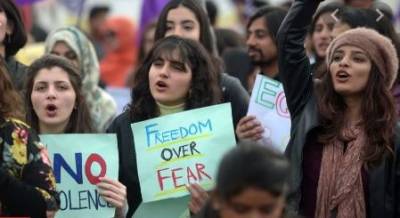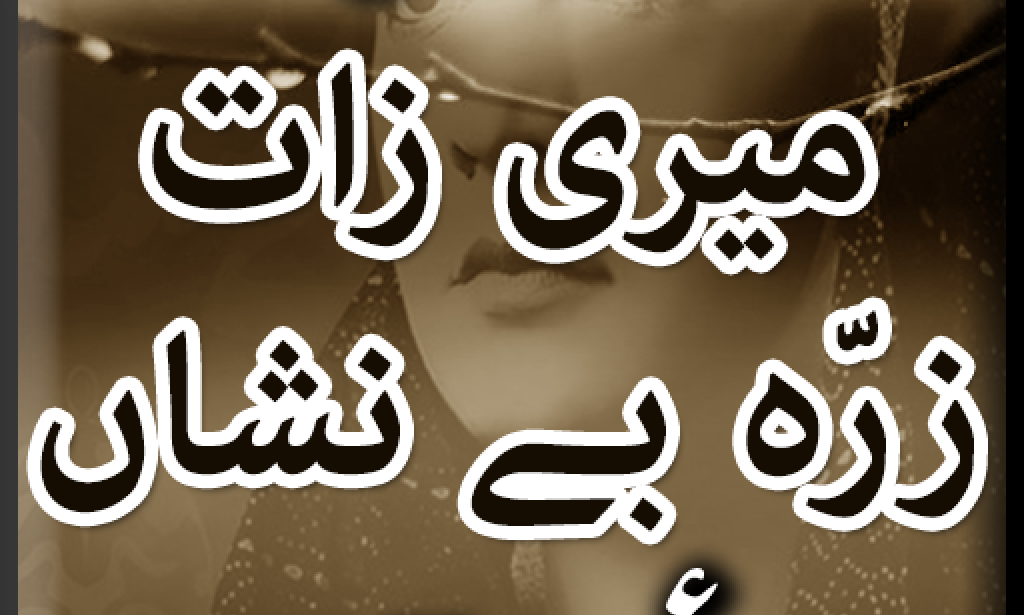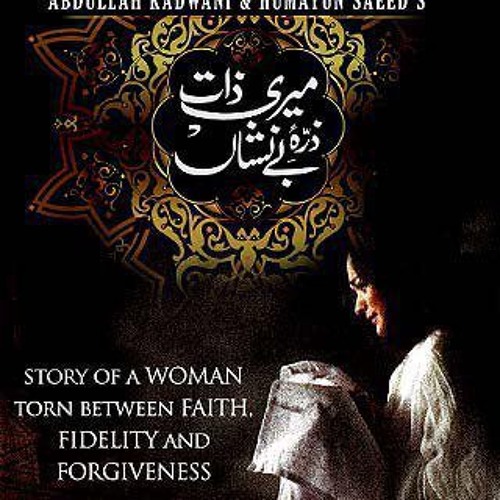Abstract: -
This work tends to the horned problem of food of ladies' concealment in Pakistani male centric
culture by fundamentally investigating a famous Pakistani Urdu tale, Meri Zaat Zara-e-Benishan,
by Umera Ahmed.Apparently, the novel appears to speak loudly for abused Pakistani ladies, yet
behind the lines, it functions as an apparatus to console the ladies to bear the shameful acts and
disparities in the man centric culture as their fate. It has been discovered that the accounts like
Meri Zaat Zara-e-Benishan have been clearing the ways for the food of male's authority. They
grant the message that the ladies are inferior and docile to the customs, qualities and standards
of the general public. They are bound and confined to the limits raised by the evil spirits of the
cultural and social standards. The essayist stamps the predetermination of the ladies through the
portrayal of tame and docile female heroes like Saba. The chains of social, social and strict
standards are just for ladies while the men of the framework are thought about generally as
absolved from these limitations.
Introduction: -
Umera Ahmad, a productive female author of present-day Pakistan remains as a broadly read
and liked essayist. In spite of the fact that Ahmad's tale Peer-e-Kamil brought her notoriety, her
screen plays and novelettes are similarly well known, particularly among ladies. A portion of her
most remarkable works incorporate Meri Zaat Zara-e-Benishan (2000), Lahasil (2000), Amar
Bail(2004), Thora Sa Asmaan (2006) Ahmad's compositions uncover a social aggression towards
ladies who endeavor to challenge a generally supported picture of uninvolved and devoted
Muslim ladies.
Meri Zaat Zara-e-Benishan, takes into consideration the assessment of the Catch 22s and
limitations that Muslim ladies endure, particularly in issue in regards to sexuality. This epic is
currently being converted into English. Ahmad writes in the Urdu language and this is one reason
why she remains as the most well-known contemporary and generally read writer in Pakistan.
English language is just utilized and perceived by a little extent of the Pakistani populace of which
ladies are significantly more modest in number. Hence, Urdu writing and fiction tracks down a more noteworthy crowd in Pakistan. Moreover, Ahmad's working-class childhood and way of life
permits her to partner and connect through her compositions with other working class ladies.
Along these lines the greater part of Ahmad's works community on female characters of the
working classes. Ahmad doesn't restrict her characters inside a specific financial class, yet
explores different avenues regarding the potential obstacles, undetectable limits and limits that
might be related with individuals' lives having a place with various different backgrounds.
Likewise, her female characters, across her created works, present a variety of dynamic
characters from house-spouses to working ladies, from quiet, inactive and exploited figures to
dynamic, strong and challenging ladies who have the limit and devise approaches to oppose man
centric abuse.
Ahmad likewise shows a hidden battle of female character that stays a distinguishing highlight of
her works. As the novel being talked about is as yet during the time spent being interpreted, a
short plot rundown of the novel is given before close assessment and examination.
Literature Review:
Pakistani authors give enough freedoms to women's activist to investigate with respect to ladies’
abuses living under man-controlled society. These literary platforms highlight the female
position in a society at large. Miti Pandey (2003) declared the job of woman's rights in writing:
“Ladies' freedom recorded as a hard copy insinuates the systems of different writers and their
first concern for the possibility of female association with it. The recounted insight of
characters, the normal, intuitional or innovative restriction of an essayist, the experience sure
in language of plan that inspects the social cures, that subordinate and make light of women
and treat them as inferiors are the fundamental concerns of female fiction researchers from
ladies' perspective.”
(Pandey, 2003,)
Literature Review:
Pakistani authors give enough freedoms to women's activist to investigate with respect to ladies’
abuses living under man-controlled society. These literary platforms highlight the female
position in a society at large. Miti Pandey (2003) declared the job of woman's rights in writing:
“Ladies' freedom recorded as a hard copy insinuates the systems of different writers and their
first concern for the possibility of female association with it. The recounted insight of
characters, the normal, intuitional or innovative restriction of an essayist, the experience sure
in language of plan that inspects the social cures, that subordinate and make light of women
and treat them as inferiors are the fundamental concerns of female fiction researchers from
ladies' perspective.”
(Pandey, 2003,)

Zia Ahmed (2009) laid stress that how literature represented the societal changes. The women’s
representation through literature significantly makes us to understand the women Standing’s in
particular community (Ahmed, 2009). During Zia’s regime women, unsurprisingly, became a
central concern in Pakistani society. Certain laws lead to this sort of conversation an open chapter
for everyone. Muneeza Shamsie (2005) explained in his works that new profanity laws came into
exist, which victimized the most fragile and the most weak ladies and minorities. (Shamsie, 2005,
p.xiii). In other words, a women’s body was tooled by purdah, modesty and shame to attain a
subordinate women. Certain restrictions were imposed on the participation of women’s majority
in certain fields. Husain Haqqani (2005) elaborated not many of the legitimate guidelines of Zia's
system in his book Pakistan; such as the restrictions on the participation of women’s in arts and
sports and the delivering of the lawful declaration of a lady to a large portion of the load when
contrasted with a man. Furthermore , prerequisite of lady or a man as an observer to their marks
prior to entering in some monetary agreement (Haqqani, 2005, p.14). Like other writers Ahmad
also depicted and explored social, political and cultural issues through certain female characters.
In “Meri zaat zara beneshan” Saba stood firm and courageous in a male dominant society. Her
writings portray that Pakistani society is utmost male-centered and the women’s are been
oppressed, they regularly needs to battle to guarantee their way of life as a person. Female
desires, emotions and often lives are been slaughtered in this so called struggle to attain their
identity. Shahraz, Sidhwa,and Ahmad penned down these famous chains around the women’s of
society and urged them to stand, oppose and raise voice to get rid of these confinements. Benet
(2008) affirmed that the feminization of talk has given ladies a legitimate voice and
authenticity.(Benet, 2008, p.133). Ladies essayists made a scholarly practice across different
cultures which enables women to raise voice about their experiences. Now according to their
understanding about the world they make their opinions public and question about the nuts been
tighten over them unnecessarily. Pam Morris in (1993) asserted:
Tracking down their own feelings, conditions and wants shared into artistic structure gave (and
keeps on giving) numerous ladies, for few it was the first run through a feeling that their own
reality was significant, that their perspective on things was legitimate and canny, that their
enduring was ensnared superfluous, and a confidence in ladies' aggregate solidarity to oppose and revamp their own lives. Ladies works recount the story describing various parts of ladies'
lives that have been annoyed , eradicated, disregarded, belittled and confused and surprisingly
romanticized.
(Morri,1993,p.60)
Ahmed’s characters of Meri zaat zara beneshan, is applicable to be set under the third period
of woman's rights in which Saba, the fundamental character, moves on an objective of selfdisclosure. Her endeavors and battles are not against a male centric male figure but rather
against the cultural standards and qualities additionally man centric designs that obstructions her
advancement. This epic counter the social standards which abuses the ladies' and left platform
where further debates can proceeded. This permits the ways to deal with close their own
understandings and figure their decisions. In spite of the fact that Saba's obstruction and intensity
to endure freely in a male focused society opens the way that how ladies can address male
mistreatment and their superfluous strength.
Pakistan being an Islamic nation, in light of Islamic belief system, any Western women's activist
thoughts was/still steadily a moving idea to guard. Women's activist considerations, equity of
people, were assumed Western motivations and straight forwardly excused as an enemy of
Islamic. Pakistani females discovered their bodies as a fight yard whereupon the couple of strictly
spurred individuals and sexist of Zia's time dispatched the sexual orientation war. Female figure
of the society found themselves being oppressed by the norms launched by the male dominance
society. Another deeper message that Ahmad conveys through her stuff that the absence of trust
is been putted in the voice of female figure of society. Likewise couple of inquiries in regards to
the ladies' voice in Pakistani society where the male ears are not familiar with hear brought up
in self-preservation. Ghulam Murtiza and Abdul Baseer (2011) talking about the connection
among language and ladies in Pakistani society stated that., “language as a similitude of force
which turns into an illustration of weakness for ladies” Sadly, the society where we live in, where we are grown up is so called a male- centered. Men
take it as their honor what they are not supposed to take and leave that as it is what it should be
taken as their honor.
Again, Ghulam Murtiza and Abdul Baseer (2011) elaborated as “Pakistani society cannot bear
equality between men and women due to the reason that it wants to see a man as more than
a man and a woman less than a woman. Any violence in this order of existence is profane”
(Baseer and Murtiza, 2011, p.559)
Diverse specialist consequently means to figure out and investigate the intricacies that
encompass the existences of females in Pakistani society. It reveals the male centric designs that
block ladies' advancement. The various ladies characters examined in the books, expounds a
mindfulness about these man centric limitations and endeavored to oppose their persecution
through various works. Therefore, the intricacies, sufferings and distresses just as the protection
from fiendishness and assurance of the different ladies' characters recommend the quantity of
ways for the advancement of females position in the social orders of Pakistan.
Short summary of novel:-

The epic opens with a young lady, Sara, coming to remain with her Uncle Arfeen, whom she has
never met. She gives Arfeen a letter, composed by her mom Saba, which demands Arfeen to care
for Sara. Arfeen is dumbfounded and delighted to have found Sara, anyway gets devastated to learn of Saba's demise. As Sara lives with Arfeen and his child in their home, she learns of her
mom's previous existence. She comes to realize that her mom was Arfeen's first cousin and was
at first hitched to him. She turns into a survivor of her mother by marriage exceptional desire as
not long after their marriage Arfeen's mom blames Saba for infidelity with Aadil, another male
cousin. To approve her allegation she swears over the Holy Quran. Saba's energetic requests of
honesty fail to receive any notice (as nobody could envision that Arfeen's mom, an evidently
committed and strict lady, would dare lie on the Quran). Saba is separated on the spot and is
subsequently offered to a lot more established man, as a subsequent spouse. Her inconveniences
don't end and as Saba gets pregnant; her better half won't acknowledge the youngster and
separations her. Saba, a twice separated from lady, abandoned by the family, starts to make her
living by at first filling in as a house servant and later, after the introduction of her girl, Sara, she
works in a processing plant. She is once situated by her Uncle (Arfeen's dad) so her withering
auntie, experiencing last stage malignant growth, could ask pardoning for her sin24. Arfeen's
mom asks absolution and admits of plotting against Saba. Saba hesitantly makes a short visit to
her uncle's home to meet her perishing auntie. In the wake of excusing her she quietly leaves
again declining to acknowledge thoughtful proposals of getting back to them. She even declines
to re-wed Arfeen who by then was a single man with one child. She vanishes with her girl Sara leaving all her family liable and embarrassed.
Feminism:-
Women's liberation, a development of ladies' privileges, begun in protection from male's
authority. Woman's rights can be characterized as an acknowledgment and scrutinize of male
matchless quality joined with endeavors to transform it. The development coordinated around
the conviction that the genders ought to be equivalent socially, strategically and financially.
Women's activists are worried about investigating the imbalances that exist among people in a
general public from a female point of view and outline how guys rule social connections and limit
the chances for ladies. Women's liberation includes political and sociological hypotheses and
methods of reasoning worried about issues of sexual orientation distinction, just as a
development that advocates sex fairness for ladies and lobbies for ladies' privileges and interests.

Analysis: -
The title of the novel, Meri Zaat Zara-e-Benishan in a real sense interprets as my self is a bit (little
molecule) that is indistinct. As such, the principal female figure of the novel, Saba, is proposing
that in the more extensive plan of the universe by and large and in the male characterized world
explicitly, she, as a lady, is permitted so little presence that it is difficult to characterize. This
intriguing title mirrors the little space ladies are given in man centric social orders. It additionally
mirrors the female longing to provoke this social shamefulness by trying to characterize and cut
out her own personality and spot inside the male ruled society. As Saba is dismissed and delivered
destitute, she doesn't lose trust however puts forth every one of the attempts to help herself and
her young little girl. Saba shrouds her unpleasant past from her little girl though Sara, as she
develops more established, stays inquisitive to think about her more distant family.
Meri Zaat Zara-e-Benishan catches the predicament of ladies at the background of a crumbling
exemplary man centric design inside Pakistani society. Ahmad along these lines presents
Pakistani society in the midst of a shift or a breakdown of exemplary male centric society, as more
youthful men leave their dad's home and take their spouses with them to new places. Saba's
auntie, who later turns into her mother by marriage, presents as a lady who likely drove her life
inside a severe more distant family and who unequivocally detests Saba's goals for schooling and
thinks of her as a wild lady. Saba's uncle, who holds incomparable authority over all the family
matters, weds both of his girls with insignificant degrees of training. Then again, he permits his
lone child, Arfeen Abbas, to travel abroad for advanced education. Saba's dad has made a trip to
the USA and in his nonattendance Arfeen's dad holds an authority over Saba's family. So, when Saba demands joining a college, she needs to look for her uncle's authorization. Saba's endless
energy for her investigations make her negative for her whole more distant family and especially
for Arfeen's folks.
Arfeen's mom is over-possessive of her solitary child, and gets irate as Arfeen, on his get back
from the USA, chooses to wed Saba. Saba's relative can't bear the way that Arfeen plans to take
Saba to the USA after their marriage. She considers her to bee’s heartfelt relationship as a danger
to her bond with him. She can't discourage him so plots an arrangement to contaminate Saba's
character through blaming her for infidelity.
Her more youthful little girl's wedding service furnishes her with an ideal chance to disgrace Saba
before a huge social event of wedding visitors. She accomplishes her motivation by fooling Saba
and Adil into a room, on the appearance of a task, and secures them. Then, at that point she calls
her better half and accumulates other relatives outside that space to show that Saba and Aadil
have been gotten together in a room. She educates everybody that she has seen their disgraceful
demonstration. The circumstance becomes extraordinary and a Kacheri is coordinated by
Arfeen's dad and Arfeen's mom dishonestly swears on the Holy Quran to substantiate herself. As
swearing over the Holy Quran is acknowledged beyond a shadow of a doubt, because of the
preeminent approval and adoration related with the book, Saba's requests fail to receive any
notice as nobody will trust her. Moreover, Aadil's getaway from the circumstance further
convolutes the circumstance for Saba as her mother by marriage shouts:
“so if he was not guilty why did he run away and hide his face in shame?”
(Meri Zaat Zar-e-Benishan, p.34)
Saba gets defenseless and Arfeen, furiously, divorces her. Ahmad, through Saba's quandary,
shows that it is so natural to misuse ladies through their sexuality. Indeed, even a slight allegation
can put ladies in circumstances where they frequently neglect to demonstrate their
blamelessness. As a discipline for soiling the family honor, Saba isn't just separated on the spot by Arfeen however she is offered to a lot more established man, a single man with four
youngsters. Accounts of such barbarities overflow with innumerable situations where ladies
blamed for infidelity are slaughtered by the relatives (for the most part fathers and siblings, even
nephews and cousins) for the sake of honour25. This issue stays quite possibly the most common
practices that abuse ladies in Pakistan as well as across the Muslim world, which merits a different
broad examination. There are additionally cases in Pakistan where an allegation against a male
individual from the family prompts the sexual exploitation of the female of that family,
remuneration. In such manner quite possibly the main cases is of Mukhtar Mai26. A lady of
Meerwala town in Punjab region, Mukhtar Mai was assaulted at the sets of the town panchayat
for honor retribution as Mukhtar's sibling was blamed for being associated with a young lady of
the contrary tribe. Mukhtar's solid character and boldness became visible as she chose to battle
her exploitation by looking for lawful assistance and media backing to cause public and
worldwide to notice the unfairness she had confronted. This was an enormous test, as Mai got
dangers and alerts . epitomizes tolerance, enduring and obstruction. Her trial is no uncertainty
more noteworthy than her transgression, which is subsequently refuted, yet Saba lives through
her discipline with extraordinary strength and endurance. Her flexibility turns into a
characterizing normal for her character that thus brings her up in our assessment. In spite of the
fact that she quietly consents to the discipline of wedding a man a lot more seasoned than her,
when her oppressive spouse tosses her out of his home she won't do homage enduring or self
indulgence.
Saba's energy for instruction turns into her type of obstruction against the inflexible perspectives
of her relatives. She feels training can prepare her to comprehend the general public and the
world she lives in. In any case, Saba understands that straightforwardly difficult the men of her
family would be of little use so she chooses to examine her issue with Arfeen, as Arfeen had as
of late got back from the USA. As he stays with her family she asks, "What is this thing called
training?" . Saba then, at that point proceeds to address him whether schooling is significant for
men just and Arfeen explains on the significance of instruction for the two people.



You must be logged in to post a comment.